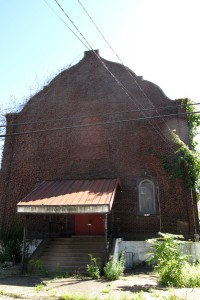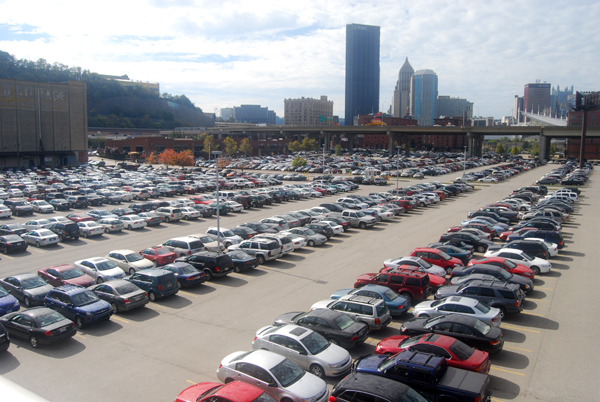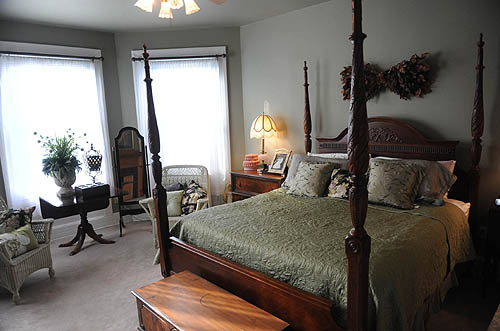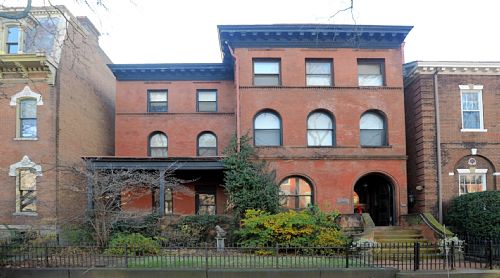
Category Archive: Architecture & Architects
-
Arts and Crafts Conference in Pittsburgh
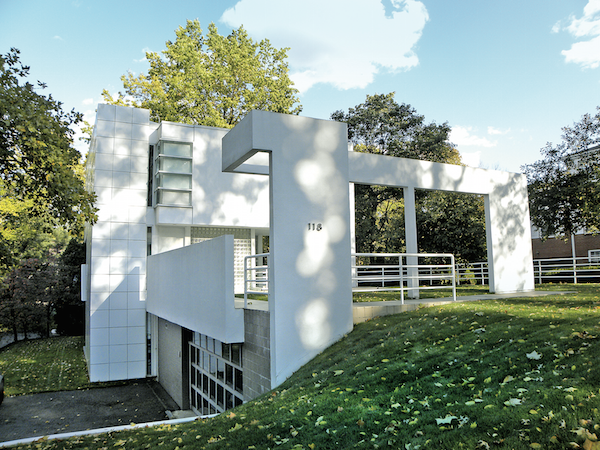 PHLF members and friends are invited to attend the 17th Annual Arts and Crafts Conference, which will be held in Pittsburgh from September 17 through September 20.
PHLF members and friends are invited to attend the 17th Annual Arts and Crafts Conference, which will be held in Pittsburgh from September 17 through September 20.Register for all four days or for any one day of this national conference sponsored by the Initiatives in Art and Culture (IAC), titled “Multiple Modernities: From Richardson to Wright and Beyond––The Arts and Crafts Movement in Pittsburgh and Environs.” As part of the “Beyond” portion of the conference, participants will be able to tour the Frank Giovannitti House, designed by Richard Meier in 1979-83, on Sunday afternoon, September 20.
Click here for a full agenda and to register. Please use the Promo Code PHLF to receive a conference discount of $475. Regular registration is $550.
Please note: the discount applies to those who register for the whole conference, not for one-day registrations. However, for those who are interested in attending more than one day but less than all four, then call the IAC at 646-485-1952. The IAC might be able to work something out and offers the warmest of welcomes to anyone who wishes to attend.
Conference organizer Lisa Koenigsberg, PhD, has planned an incredible agenda of tours and lectures (including one by PHLF trustee Lu Donnelly and one by Historical Collections Director Al Tannler). “Pittsburgh is astonishing,” said Lisa. “There is so much to showcase and explore.”
Participants will be touring Wilpen Hall in Sewickley Heights (protected by a PHLF easement); the Duquesne Club in Downtown Pittsburgh; several private homes, including an Arts-and-Crafts foursquare in Squirrel Hill featuring a superb collection of furniture and art; and several historic religious properties in Downtown, Shadyside, and Sewickley.
“This is a terrific opportunity to tour a selection of significant sites in the Pittsburgh region,” said PHLF Executive Director Louise Sturgess, “and to immerse yourself in the Arts and Crafts tradition.”
Conference partners include PHLF, the Frick Art & Historical Center, Carnegie Museum of Art, Fallingwater, and Kentuck Knob, among others.
Register today!
-
Historic Swissvale Church Receives Second Life as Condominium Development
John Farley, Pop City Media
Wednesday, January 26, 2011
The Madonna del Castello Church at 7416 Duquesne Avenue in Swissvale has sat vacant for five years since its congregation left, leaving the unique brick building to fall into considerable disrepair. The church will experience new life as (a) condominium complex thanks to a partnership between the community, The Mon Valley Initiative, and the Swissvale Economic Development Corporation, who have begun construction that will incorporate many of the church’s original architectural features into the redesign.
“Its reuse as a church wasn’t going to be feasible so we looked at other options to maintain this part of the neighborhood,” says Patrick Shattuck, senior real estate developer for The Mon Valley Initiative, who purchased the property last September for $10,000.
Working with plans by Lami Grubb Architects, Mistick Construction is currently installing structural steel supports and expects the project to be completed by late spring or early summer. The plaster moldings and original arches will stay, becoming part of the new townhouse-style condos.
Three of the four condos will be 1,600-square-foot, two-bedroom, one-and-a-half-bathroom units. The fourth condo will be a 2,400-square-foot, three-bedroom, two-and-a-half-bathroom unit, which will feature the large dome that is currently over the altar as part of the space. The condos will range in price between $80,000 to $105,000.
A former rectory and convent next door to the church had to be demolished but the vacant lot where they once stood will soon be put to good use. “We had hoped to renovate the buildings, but ultimately they proved to be too far gone. It is a buildable lot, so whether we include that in the future phase for a house or whether we leave it for public green space will be determined,” says Shattuck.
Writer: John Farley
Source: Patrick Shattuck, The Mon Valley InitiativeImage courtesy of The Mon Valley Initiative
-
Pittsburgh Athletic Association Centennial Event: Lecture, Tour and Dinner for PHLF Members and Friends
Here’s your chance to explore one of Pittsburgh’s most elegant private clubs. Join us Wed. evening, Feb. 2, 2011, from 5:30 to 9:00 p.m., at the Pittsburgh Athletic Association, 4215 Fifth Avenue, Pittsburgh, PA 15213 (Oakland).
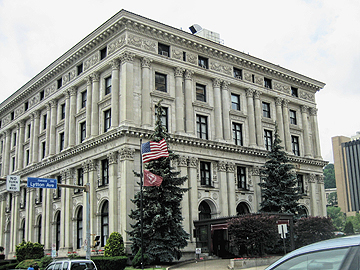
Evening Agenda
- 5:30: Cash bar
- 6:00: Illustrated lecture by David J. Vater, RA and PHLF Trustee, on the architects and on the significant design features of the PAA.
- 6:30: Guided tour of the clubhouse, including the swimming pool, basketball court, and bowling alley.
- 7:15 Dinner in the Main Dining Room
Entree Choices (choose one when you make a reservation):
- Twin Jumbo Crab Cakes
- Strip Steak Au Poivre
- Eggplant stuffed with cilantro ginger pesto
The Pittsburgh Athletic Association (Janssen & Abbott, architects, 1909-11) is one of the most elegant buildings, both inside and out, in Oakland’s Civic Center and is listed on the National Register of Historic Places.
This event, on the occasion of the PAA’s centennial, is one in a series of private clubhouse tours organized by the Pittsburgh History & Landmarks Foundation for its members and friends. In previous years, Mr. Vater has led events at the Twentieth Century Club, Longue Vue Club, and Fox Chapel Golf Club.
Reservations must be pre-paid by Thurs., Jan. 27, 2011.
Valet parking is available in the PAA lot, via the entrance from Lytton Street. Purchase a parking token for $8 at the front desk of the Club.
Parking is also available in the Soldiers and Sailors Museum garage on Bigelow Boulevard and in the Holiday Inn University Center garage on Lytton Street.
Time: 5:30pm – 9:00 p.m.
Meeting Location: Pittsburgh Athletic Association, 4215 Fifth Avenue, Pittsburgh, PA 15213 (Oakland)
Fee: $60 PHLF and PAA members; $75 non-members. (To receive the discount, become a PHLF member.)
Reservations must be pre-paid by Thurs., Jan. 27, 2011.
Questions/Reservations: marylu@phlf.org; 412-471-5808, ext. 527 or
REGISTER ONLINE by clicking HERE -
Golden Triangle Buildings Could Get Face-Lifts
Sunday, December 26, 2010
By Mark Belko, Pittsburgh Post-GazetteThe city is looking to brighten up some “dark corners” Downtown.
Aided by a $4 million state redevelopment assistance grant, the Urban Redevelopment Authority hopes to target rundown buildings Downtown and work with property owners to upgrade them.
The project is designed to supplement a larger revitalization in the Golden Triangle that already has included the construction of the Three PNC Plaza office tower and the redevelopment of a former five-and-dime store and a department store into residential, retail and other uses.
With much of that work completed, the URA has decided to go after properties “in need of some reinvestment” — not to buy but to approach and work with the owners about making improvements.
“This is really a building-by-building, block-by-block approach,” said Yarone Zober, URA board chairman and chief of staff to Mayor Luke Ravenstahl.
Mr. Zober said the genesis for the idea came during walks he and Mr. Ravenstahl had Downtown.
“One thing the mayor and I noticed at street level were individual buildings that needed work … or didn’t have street-level appeal. They detracted from the general feel and look of the Downtown corridor,” he said.
“It became very clear that we needed new tools to continue the revitalization of Downtown.”
Funds from the grant, awarded by Gov. Ed Rendell earlier this month, can be used to make facade improvements or to address “life safety” issues that prevent property owners from using upper floors for residences or other purposes.
Life-safety improvements could include stairwells, elevators or other measures to bring buildings up to code. URA executive director Rob Stephany said such improvements typically run $250,000 at the minimum.
While projects like Three PNC, Piatt Place and Market Square Place have helped to transform Downtown, there are other buildings still in need of work, including some near the upscale Capital Grille restaurant at Fifth Avenue and Wood Street, Mr. Stephany said.
“You go to wait for the valet to bring your car back and there’s blight staring you in the face,” he said.
Properties the city initially is targeting for possible work include the Thompson Building on Market Street between Fifth and Market Square and a building owned by the Order of Italian Sons & Daughters of America at Wood and Forbes Avenue that once housed a McDonald’s restaurant.
Also on the list are three buildings at the western corner of Fifth and Wood that house a jewelry store and other retail outlets and a couple of buildings on Wood owned by the URA itself.
Mr. Zober said the URA already has had discussions with the property owners about potential improvements.
David Kashi, owner of the Fifth and Wood properties, said he hopes to secure funds to upgrade the facades of the buildings. He plans to install new windows and perhaps add a marquee to the front of the buildings. He also is thinking about placing a “big clock” on the corner building.
“We’re going to make Downtown beautiful,” he said.
Mr. Kashi said he already has had one meeting with the URA and plans to have another next month to work out plans and budgeting. He had no estimate for the cost of improvements.
He likes the city initiative.
“Downtown is the center of the whole Pittsburgh area. I think it’s about time someone took the initiative and improved the look. Nothing has changed in 50 or more years,” he said.
Improving the overall ambiance also “attracts investors to bring money into Downtown Pittsburgh,” he said.
The program will require property owners to match amounts received from the URA. Mr. Kashi is not thrilled about having to do so but said he would to increase the value and curb appeal of his properties.
The Thompson Building, which once housed the Ciao Baby restaurant, is owned by the Pittsburgh History & Landmarks Foundation, which already has redeveloped three adjoining buildings at Market Street and Fifth.
Arthur Ziegler Jr., president of the foundation, said the organization plans to restore the facade of the Thompson Building, which likely will play host to some type of restaurant, bar or cafe.
Mr. Ziegler said the building once housed a restaurant operated by the Chicago-based Thompson restaurant chain. The chain at one time had six restaurants in Pittsburgh, but the Market Square building is the only one that has survived.
It was purchased by John R. Thompson in 1926, but dates back farther than that, perhaps to the turn of the century.
“It is an important part of Pittsburgh history,” Mr. Ziegler said.
Besides restoring the exterior, the foundation will “try to meet the green standards that we’ve established down there and we want to get the building in service as soon as possible in 2011,” he said.
The foundation spent $3 million restoring the original facades of the three adjoining buildings, which house a men’s clothing store, a shoe store and apartments. It plans to make a substantial investment in the Thompson Building but also is looking for help from the URA to fill in the gap.
“We did not do that with the first three buildings. We provided the funds. We need some help with this fourth one,” Mr. Ziegler said.
Like Mr. Kashi, Mr. Ziegler believes there is a need for the type of program the URA is starting.
“I think it’s excellent. We need to continue to recognize the value of these historic buildings and improve their exteriors and their basic interiors to meet building codes,” he said.
At the site of the former McDonald’s restaurant, the city would like to remove the burnt-orange metal facade that covers the upper floors and restore the building’s original exterior.
Mr. Ziegler said that underneath the current facade the building features an attractive stone architecture. “It was a handsome corner and we would like to see it be that again,” he said.
Officials at the Order of Italian Sons and Daughters could not be reached for comment.
While the URA has targeted some real estate, any Downtown building owner interested in upgrading a property can contact the agency about possible aid, Mr. Zober said.
The city’s effort is unrelated to six acquisitions totaling $15.15 million made by an unidentified buyer on the east side of a block bordered by Wood, Fifth and Forbes over the past eight months.
While the identity of the buyer is not known, many in the real estate community believe it is PNC Financial Services Group, which built Three PNC Plaza. A PNC spokesman has said, “We don’t comment on speculation.”
There’s much talk that the block could be the site of the next big development Downtown. In the meantime, the city is hoping to fill in the cracks.
“Our goal is to really make Downtown look complete,” Mr. Zober said.
-
Buncher Co. to Redevelop Terminal Produce Building and Build on Unused Riverfront Land
Pop City Media
Wednesday, December 15, 2010
The Urban Redevelopment Authority has agreed to lease–with an option to sell–the 130,000-square-foot Fruit Auction Terminal Produce Building on Smallman Street in the Strip District. The Buncher Co. plans to turn the building into a thriving commercial space.
To purchase the building, Buncher must commit to building 75-units of residential housing on the 55-acres of surface parking behind the Terminal Building. The firm must also promise to preserve the historic architecture.
“The building really is at the end of its useful life. It needs anywhere from $6 to $10 million in capital improvements to bring it up to code and preserve it,” says Rob Stephany, executive director of the URA.
According to Stephany, Buncher is about 20% of the way into their planning process, having selected the renowned historic preservation architect Albert Feloni to create a master plan for the Terminal Building. Astorino is under contract to do the master plan for the vacant surface parking along the river between the convention center and 41st Street.
Once Buncher submits the master plans to the URA for review, the gears of construction can really start turning. Stephany says a recently conducted market analysis indicates the building would best benefit from restaurants, office, and showroom spaces on the platform, citing the Society for Contemporary Craft and The Pittsburgh Public Market as examples of forward-thinking reuse of these kinds of buildings.
As part of the project, the URA and the City recently rezoned part of the Strip as a redevelopment area, causing concern from some neighborhood stakeholders who thought the URA might be preparing for eminent domain seizures. Stephany says that while this is certainly not the case, they didn’t do a good of a job in communicating their plans. Their intent was to make funds from investors more flexible.
Sign up to receive Pop City each week.
Writer: John Farley
Source: Rob Stephany, URA
Photograph copyright Brian Cohen -
Buying Here: Bellevue
Saturday, December 04, 2010By Rosa Colucci, Pittsburgh Post-Gazette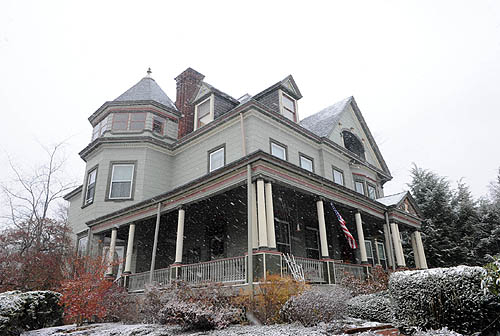
This five-bedroom, 4 1/2-bath home in Bellevue has 5,500 square feet of living space. Michael Henninger/Post-Gazette
“It takes my breath away every time I walk through the front door. It’s a warm, wonderful house,” says Sharon Hruska of her house in Bellevue.
There are very few houses that can evoke that feeling, but she isn’t exaggerating. Her five-bedroom, 4 1/2-bath Queen Ann-style house at 108 Meade Ave. (MLS No. 841177) is on the market for $299,000 through RE/MAX Realtors Don and Kathy Seaton (724-933-6300, ext. 664; or www.seatonteam.com).
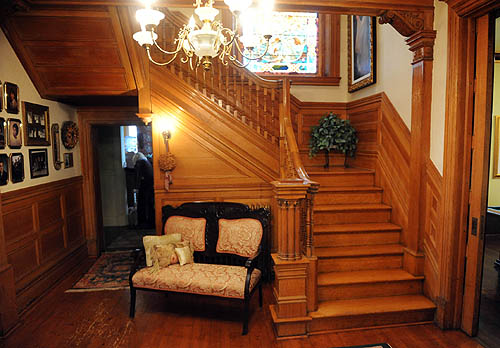
The home was built in 1898 by a lumber mill owner, who spared no expense on the wood work, including the entryway that has a carved oak staircase. Michael Henninger/Post-Gazette
When you open the front door, you are greeted by a 30-by-8-foot entryway that features a carved staircase in gleaming oak. The home was built in 1898-99 by Michael Simon, who owned a lumber mill and spared no expense.
When Sharon and Ken Hruska purchased it in 1993 for $40,000, its more than 5,500 square feet of living space was divided into nine apartments. The splendid foyer and all other woodwork were painted white. The couple spent a year restoring the home before moving in.
“My husband stripped the foyer. It took him one solid year; he worked every single day,” Mrs. Hruska said.

There is plenty of room to entertain in the 19-by-16-foot family room. Michael Henninger/Post-Gazette
This and other labors of love are evident in every nook and cranny of this grand home. The main living level has six fireplaces and an assortment of rooms perfect for entertaining. The living room (parlor) measures 18 by 16 feet and has 9-foot ceilings, tall windows and a picture rail. The 19-by-16-foot family room has a carved fireplace and a more masculine feel, decorated in traditional leather. The dining room (26 by 15 feet) has a pair of chandeliers and another fireplace, this one with a ceramic tile hearth offsetting the hardwood floors that cover most of the first floor.
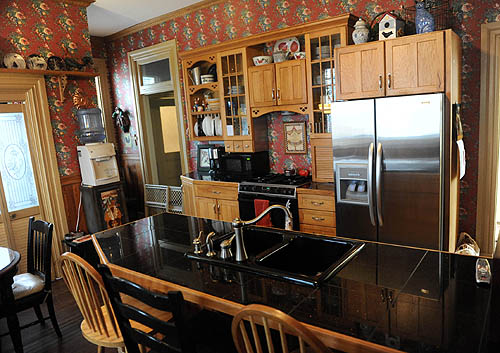
The 27-by-15-foot kitchen has granite counters and stainless-steel appliances. Glass-front cabinet doors flank the cooking area and accent exposed shelving. Michael Henninger/Post-Gazette
The 27-by-15-foot kitchen is a cook’s dream, with granite counters, stainless-steel appliances and an exposed-brick wall that nicely complements the modern appliances and amenities. Glass-front cabinet doors flank the cooking area and accent exposed shelving.
Nearby is the 18-by-16-foot den that doubles as a billiards room. Rounding out the main level is laundry room that measures 16 by 16 and a powder room.
A back staircase offers access to the huge third floor that could be rented as a full apartment. The space has three bedrooms, a full kitchen, living room and full bathroom.
Going up the front staircase to the second floor, be sure to stop to admire the majestic stained-glass window that the homeowners were able to retrieve and put back in place years after they bought the house.
The master bedroom has a trio of windows, a full master bath suite with a jetted tub that faces a fireplace, a stand-alone shower and a pedestal sink. There are two more full bathrooms and two more bedrooms (one of which is being used as an office). Room sizes range from 14 by 14 feet to 17 by 16 feet.

The master bath has a jetted tub that faces a fireplace, a stand-alone shower and a pedestal sink. Michael Henninger/Post-Gazette
The home is heated by radiator heat and cooled by room air conditioners, which stay with the home. Outside, the stunning wrap-around porch could entertain 50 people. The homeowners added a separate three-car garage to accommodate family and friends.
Now planning to downsize, the Hruskas say their grandchildren don’t want them to leave this house and friendly neighborhood, where many young families have moved recently. The house is open by appointment.
The property has a full market value of $155,000 (www2.county.allegheny.pa.us/RealEstate). In the past three years, four properties have sold on Meade Avenue ranging in price from $48,900 in April 2010 to $113,000 in June 2008 (www.realstats.net).
“Sometimes you go in big old houses [and] they have a creepy, scary feeling,” Mrs. Hruska said. “We have always felt at home here since the day we walked through the front door.”
 Bellevue
Bellevue
At a glance- Website: bellevueboro.com
- Size: 1.1 square miles
- Population: 8,770 (2000 census)
- School district: Northgate (northgate.k12.pa.us)
- Enrollment: 1,294
- Average 2010 SAT scores: 476 verbal; 494 math; 470 writing
- Current taxes on 108 Meade Ave. (full market value of Strong55,000): $6,019
- Municipality: $1,085 (7 mills)
- School district: $4,278 (27.6 mills)
- County: $656*
- Wage tax: 1 percent, split between municipality and school district
- A little bit of history: Like many northern suburbs, Bellevue originally was part of the Depreciation Lands reserved for Revolutionary War veterans. It has the distinction of being incorporated in 1876 only after Frankie East was born. Frankie’s birth gave the town a population of 300, the necessary prerequisite for residents to file a petition for incorporation with the Allegheny County Court of Quarter Sessions.
*Includes the Act 50 Homestead Exclusion, which reduces assessed market value by $15,000 for county taxes.
-
Allegheny West’s Annual Holiday House Tour Shows Off Style, Taste and City History
Saturday, December 04, 2010By Patricia Lowry, Pittsburgh Post-GazetteOn Thanksgiving eve, when I called Alex Watson about previewing his house for next weekend’s Allegheny West Victorian Christmas House Tour, I assumed it would be too early to see it in holiday garb.
“Oh, that won’t be a problem,” he said. “My Christmas tree has been up for three years.”
When your house has been on the tour for 28 of the event’s 29 years, leaving the artificial tree up and decorated in a corner of the library seems the expedient thing to do.
Next to it, on the mantel, stands the illuminated Dickens Christmas village Mr. Watson made decades ago of fiberboard, crowned by London’s St. Paul Cathedral and complete with Scrooge & Marley’s counting house. It’s now a year-round feature, too.
And next to that, on the wainscot ledge, stand a dozen smaller buildings closer to home, representing Allegheny West houses that have appeared on neighborhood tours. He and his neighbors made those, too, for sale to tour-goers in years past.
Anything to support his beloved Allegheny West, the North Side neighborhood in which he and his late partner, Merle Dickinson, settled in 1960, when they purchased the North Lincoln Avenue home. Then broken into 17 (now 10) apartments, it was far from the showplace it is today.
The red brick house, originally a two-story built between 1864 and 1865, was enlarged to its present three-story size and Romanesque Revival appearance in the early 1890s, when a library also was added to the front of the house.
Grain merchant John W. Simpson was the original owner; Joseph Walton bought it in 1888 for daughter Ida Walton Scully and her husband, glass manufacturer James Scully. In 1917 the house was sold to James S. Childs, a shoe, rubber and leather wholesaler whose wife Alice was Ida Scully’s sister.
In 1923 the house changed hands again; the new owners were Samuel and Margaret Crow, who lived there and rented rooms to boarders. The house stayed in the Crow family until 1960.
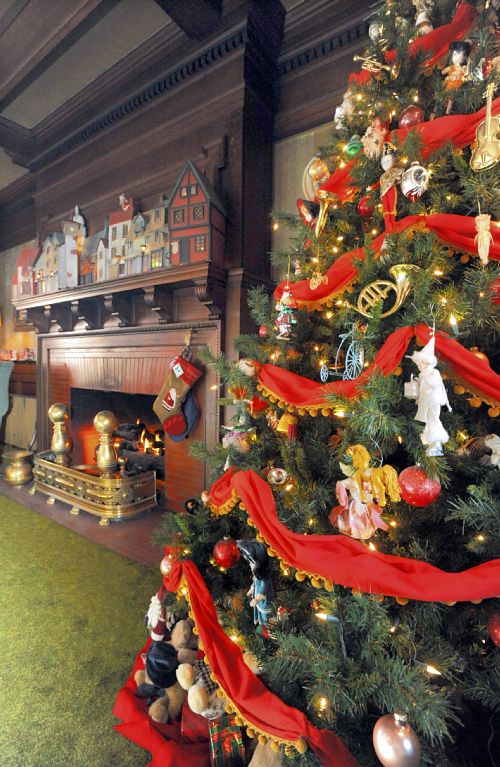
The library in Alex Watson's North Lincoln St. home is decorated for the holidays. Bob Donaldson / Post-Gazette
The house’s architect is unknown; none surfaced during architectural historian Carol Peterson’s extensive house history research. Mr. Watson thinks it may have been Longfellow, Alden and Harlow, who in 1889 completed a house across the street commissioned by B. F. Jones for his daughter Elizabeth and her husband, Joseph O. Horne, son of the department store founder. It’s a good bet, considering the richly carved and paneled oak interior finishes, the melding of medieval and classical influences and a first-floor layout similar to the Horne house. The firm designed 13 buildings within a radius of several blocks and Frank Alden had lived just around the corner.
Restoring the home’s original features became a decades-long passion for Mr. Watson and Mr. Dickinson, who did much of the work themselves. And there was much work to do. While most of the interior woodwork remained, the first floor’s front parlor, library and dining room had been its own apartment with kitchen and bath.
One bathroom occupied a corner of the entrance hall; during its removal, the owners discovered a long-lost corner of the hall’s original mantel. From that remnant, they re-created the mantel and over-mantel and warmed up the room with a gas fireplace.
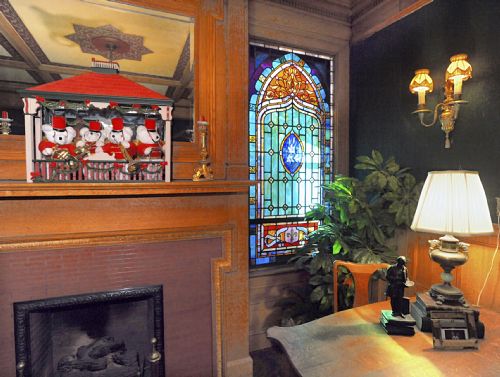
The hallway in Alex Watson's North Lincoln St. home is decorated for the holidays. Bob Donaldson / Post-Gazette
Mr. Watson has his regrets, including removal of a mantel and overmantel in the front parlor to gain wall space. They recycled it as a bar and back bar in the former kitchen, now a game room outfitted as a bordello dedicated to 1920s neighborhood madam Nettie Gordon. Eventually, in atonement, they purchased a white marble Italianate mantel from a Sewickley house sale for the front parlor.
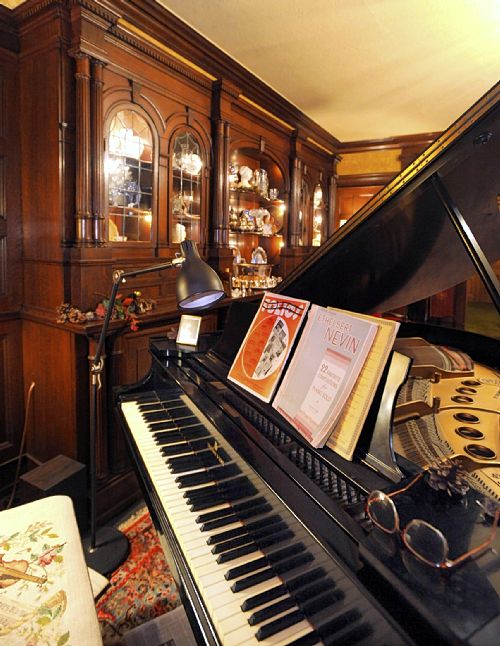
The music room in Alex Watson's North Lincoln St. home. Originally the home's dining room, the breakfront still dominates the room. The home will be on the Allegheny West Christmas House Tour. Bob Donaldson / Post-Gazette
In the former dining room, now the music room, Mr. Watson (on the piano) and friend Mark Schumacher (on the organ) plan to greet tour-goers, as they have in years past, with songs of the season. Seeing the faces of visitors as they enter the room, Mr. Watson said, “makes the whole thing worthwhile.”
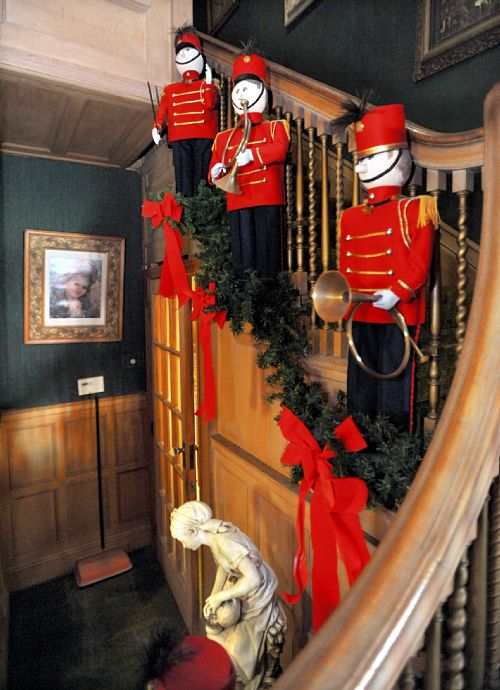
The hallway in Alex Watson's North Lincoln St. home is decorated for the holidays. Bob Donaldson / Post-Gazette
Trained in nursery and landscape management at Michigan State, Mr. Watson managed the garden shop at Sears for 27 years before it became part of Allegheny Center. His courtyard garden, glimpsed through the oak-paneled music room windows, has been featured on neighborhood garden tours; this time tour-goers will pass through it as they leave.
The six houses on the tour, spread over three blocks, include Gretchen Duthoy’s red brick, Second Empire-style Beech Avenue home, a newbie to the event.
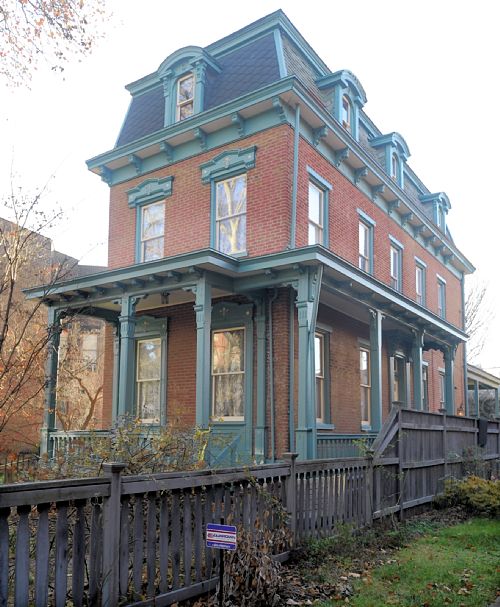
This home at 849 Beech Ave. will be on the Allegheny West Christmas House Tour. Bob Donaldson / Post-Gazette
“My house was turning 150 this year,” said Ms. Duthoy, who wanted to do something to mark the occasion. She commissioned a house history from Ms. Peterson, who discovered the house in fact was 140 years old, having been built in 1870 for railroad conductor Theodore Gray and his wife Annie. The longest ownership — 1887 to 1922 — came with four generations of the family of Christian Stoner, partner in a Strip District lumber mill.
When Ms. Duthoy, an Alcoa employee who grew up in suburban Maryland, bought the house in 2003, it had been restored by its previous owners, for whom she’d worked as a baby sitter in college.
“That’s how I came to know the house and the neighborhood and that’s how I came to live there” a few years later when they had outgrown it, she said.
Her work on the house has been cosmetic, including a kitchen update. For the tour she’ll hang family ornaments on her live tree and decorate extensively with fresh greens.
The tour, she said, is “a great showcase for the neighborhood, and I’d like to do my part.”
Allegheny West Victorian Christmas House TourInformation: Guided walking tours cost $25 per person and leave from Calvary United Methodist Church, Allegheny and Beech avenues, at 12-minute intervals from 5 to 8 p.m. Friday, and 10 a.m. to 8 p.m. next Saturday, with a maximum of 25 guests per tour. Tour guides will talk about 19th-century holiday traditions and the history of the neighborhood and the homes on the tour.
At the end of the event, which lasts about three hours, tour-goers can visit John DeSantis’ miniature railroad village and toy train collection at Holmes Hall, 719 Brighton Road, for an additional $10, as well as the Holiday Shoppe at Jones Hall, with antiques, gifts and handcrafted items. Mr. DeSantis’ train collection, open to the public only during the Christmas tour, also can be visited separately; hours are 7:30 to 10 p.m. Friday and 12:30 to 10 p.m. Saturday.
Special tours include a wine tour at 6 p.m. Friday, with wine tasting and hors d’oeuvres at a private residence, followed by the house tour ($75 per person). On Saturday, brunch tours will be offered at 10 and 10:30 a.m. and high-tea tours at 3 and 3:30 p.m. ($50 per person), followed by the house tour. With help from The Center for Hearing and Deaf Services, a signed tour will be offered at 3:36 p.m. Saturday ($25 per person).
Tours are rain or shine, snow, sleet or hail. As the Allegheny West Civic Council’s website puts it, “This is Pittsburgh and bad weather is part of the charm.” Reservations are required for all tours and tickets are nonrefundable. Visit the website (alleghenywest.org) or call 412-323-8884.
-
3 Options Offered to Revitalize South Park
By Matthew Santoni
PITTSBURGH TRIBUNE-REVIEW
Thursday, December 2, 2010A cluster of former fairground buildings along Brownsville Road in South Park could get a green makeover, under three plans officials presented Wednesday night as part of Allegheny County’s effort to revitalize the park.
Titled the “modified,” “campus” and “picturesque” concept plans, each offers an increasing degree of replacing parking lots, roads and rundown halls with green space and walking paths, said Todd Brant, project manager for Homestead-based GAI Consultants.
The modified plan would demolish Schoonmaker Hall, replace some parking lots with grassy areas that can still support overflow parking and add more pedestrian pathways to the site, which Brant said is “a sea of asphalt.”
“The fairground is unique in this large concentration of buildings, but it’s not as park-like as the rest of the park,” he said.
The campus plan would go slightly greener by moving more parking near McCorkle Road, cutting out sections of access roads and demolishing a few more of the old fair buildings.
The picturesque concept would go furthest by removing the oval track and replacing it with a more meandering walking trail. The bleachers, tennis and basketball courts would be removed and replaced with trees, and the concrete channel for Catfish Run would be removed for a more natural-looking stream.
County Parks Director Andy Baechle emphasized that the plans, which won’t be finalized until the end of the year, will only be a guide until funding to make the changes is found.
“We don’t have funding in hand to do things right away,” he said. “But with this plan and good public participation, we’re more likely to get money from foundations, from the state and federal governments.”
The plans will be posted online today and public surveys can be taken until Sunday at alleghenycounty.us/parks/SPFairgrounds.

